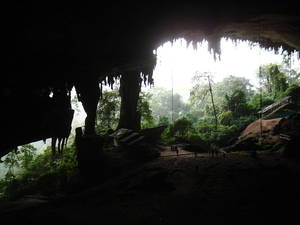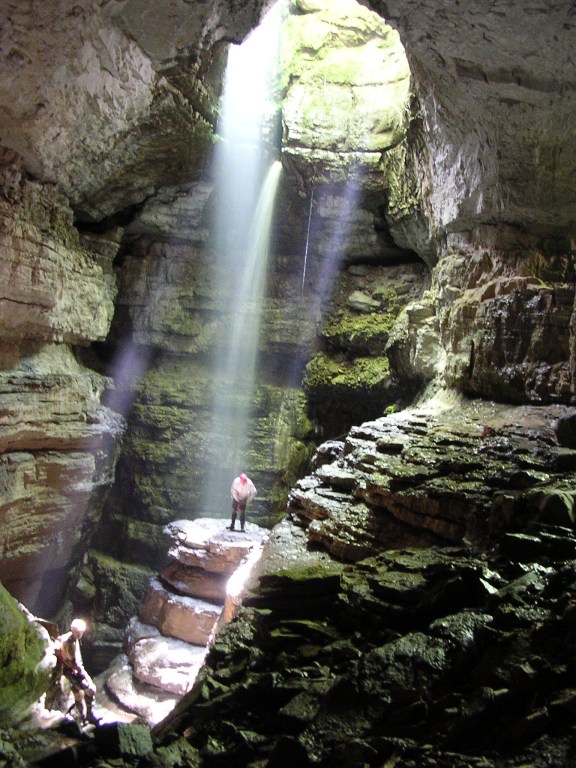Unique life in a Romanian Cave
Interview with
Chris - We are looking at life that flourishes in the absence of input from the Sun, in other words, some of the most inaccessible places on the planet. One of them is Movile, a cave in Romania. This was discovered 25 years ago. It's got no natural entrance and we think it's been cut-off from the outside world for over 6 million years. Nevertheless it's home to a thriving ecosystem of complex life including water scorpions, worms and spiders, and they're all surviving in the absence of any energy input from the Sun. Fewer than 30 people have been in this cave to date, but last April, Warwick University microbiologist Rich Boden became the first British scientist to go in and in fact he's going back very soon to continue the work he started - but today, he's with us to tell us about this extraordinary place. Hello, Rich.
Rich - Hi.
Chris - So first of all, set the scene for us. This cave sounds fantastic.
 |
| Niah Caves © mailer_diablo |
Rich - Yeah. It was discovered accidentally as these things tend to be - 25 years ago as you say. It's located in the very site of Romania, near the border of Bulgaria, close to the city Mangalia, which is a very geothermally active area. There's a lot of sort of methane seeps and sulphidic mud. It's a spa town really. Near there is a sink hole known as Obanul Mare which is just outside the city, and 25 years ago, it was thought this might be a good place to build a geothermal power station. So a series of prospecting shafts were dug about 30 meters deep and one of them struck scientific gold really when it crashed into the tunnels of this cave which they then sent the cave scientists down and discovered it had no entrance at all, promptly sealed it up, plans for the power station were cancelled and it's been being studied ever since.
Chris - How did they know that there this extraordinary ecosystem in this cave?
Rich - Basically, they went in and had a look. Christian Lascu, who is now the editor of National Geographic in eastern Europe, went in and had a look. He's a very prominent cave scientist in Romania and had to crawl around, discovered a chamber about 15 minutes crawl into the cave, which is flooded. It contains a lake, we refer to it as the lake room, which was absolutely crawling with insects and amphipods, and spiders, and what have you, and immediately had the cave sealed off so it could be studied.
Chris - How do they know that this cave is completely divorced from the outside world, so in other words, there is no energy flow from the Sun going in there?
Rich - Well there's a number of reasons. One, we know there's no rainwater seeping down into it because of a very thick layer of hydrophobic clay located above the cave. There's no stalactites in the cave, no evidence of water coming in. 1986 when the cave was discovered, was also the year of the Chernobyl disaster and the surrounding soil in that area of Romania was covered in radio-isotopes, but the cave was not and still is not containing those isotopes. So we know from that extent, it's sealed off. It's also devoid of the bacteria that we would usually associate with faecal matter that would be found in the surrounding farmland, and from obviously, humans that go in. It's completely devoid of those and we've checked that recently, and there is still no contamination, even though people have been going in and out for 30 years nearly.
Chris - Now you're a microbiologist, so you're presumably very interested in - you mentioned microbes - in the microbial communities that are in there, aside from the big stuff. So, what are those microbes doing in this cave and how are they presumably sustaining all the other life that's in there?
Rich - That's absolutely right. The microbes basically are the trees of the cave. If you think of a standard ecosystem on the surface, trees fix carbon dioxide into sugars and higher molecules using photosynthesis - they use light to fix carbon dioxide. In the cave, on top of the surface of the water, we have floating mats of bacteria. It looks like wet tissue paper, but it is actually just entirely composed of bacteria and what they do is chemosynthesis which is, they fix carbon dioxide at the expense of things like sulphide and ammonia that are found in the geothermal waters. What happens then is the mat forms, and things like nematodes and small amphipods in the water come along and eat it, which then in turn get eaten by other things, and that goes up the food web.
 |
| A Cave in Alabama © Kymacpherson @ Wikipedia |
Chris - This is not dissimilar to other discoveries that have been made around the world in other places, albeit obviously, it's unique. I'm thinking of an example in South Africa a few years ago. A lady called Lisa Prat, we interviewed here on the Naked Scientists, she had a paper in Science where down a gold mine, 3 kilometres underground, they uncovered microbes that were surviving perhaps for 40 million years, cut-off from the outside world. They were living on isotopes or radioactivity in the rock because the radioactivity was splitting water molecules which was then attacking other minerals in the rock, releasing forms of sulphur that they could eat. So this is a sort of a correlate of that, isn't it?
Rich - It's similar. The bacteria that survive on radio isotopes are a different functional group really. The bugs that are found in Movile are actually found everywhere really. You find these sulphur oxidising bacteria in normal soils and lakes everywhere really. Also found in the Deep Sea hydrothermal vents that you already mentioned.
Chris - So, what will you actually be asking in terms of the questions that surround this cave? Is this actually how you got the community of microbes that are there and how they establish this food web or are there other questions about how they can inform various industries and economies on the surface now?
Rich - I guess our real question could be, an analogy really of the UK census that's going on today; it's sort of who lives where, what do they do, how do they relate to everything else, and how did that mat form, what else is in the mat part from chemosynthetic bacteria because it's actually far more complex than that. It's also full of bacteria that oxidise methane, for example. And methane and carbon dioxide are the two biggest greenhouse gases, so we're always very interested in things that can oxidise those, particularly in the absence of light. If you wanted to set up some kind of carbon dioxide stripping bioreactor for example that has been set up previously using algae, you wouldn't need to supply light for it, so it wouldn't be weather dependent if you used chemosynthetic bacteria for example.
Chris - What sorts of steps do you have to take to make sure that this pristine environment isn't spoiled by you going in and studying it?
Rich - The cave for a start is only accessible a certain number of times per year, only a certain amount of material is allowed to be removed, the scientists we work with at the Romanian Academy , and the Emil Racovita Institute of Cave Sciences in Bucharest are also very strict what can and can't be done on the cave. When we go in, there's obviously a 30-meter shaft that you have to descend on a rope. At the bottom of which is a trap door which keeps out outside matter, our boiler suits are as clean as they can be, our shoes are not in contact with outside soil. So obviously, we can't sterilise ourselves, but we do take the best steps we can, not to take anything in.
Chris - Rich, thank you and stay with us. That's Rich Boden from the University of Warwick. He's been to Movile Cave in Romania where he works on the microbial communities there.
- Previous Getting under the Skin of Melanoma
- Next Life at Hydrothermal Vents










Comments
Add a comment